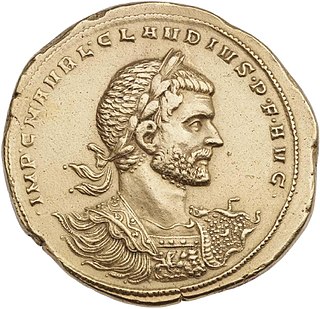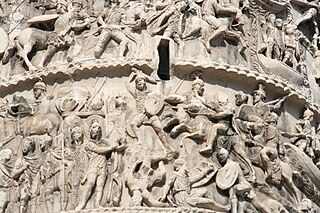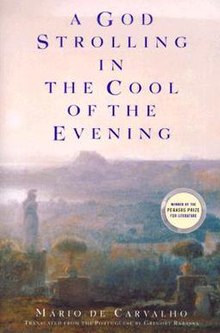
Marcus Aurelius Antoninus was Roman emperor from 161 to 180 and a Stoic philosopher. He was a member of the Nerva–Antonine dynasty, the last of the rulers later known as the Five Good Emperors and the last emperor of the Pax Romana, an age of relative peace, calm, and stability for the Roman Empire lasting from 27 BC to 180 AD. He served as Roman consul in 140, 145, and 161.
The 170s decade ran from January 1, 170, to December 31, 179.
The 180s decade ran from January 1, 180, to December 31, 189.
The 280's decade ran from January 1, 280, to December 31, 289.

Year 180 (CLXXX) was a leap year starting on Friday of the Julian calendar. At the time, it was known as the Year of the Consulship of Rusticus and Condianus. The denomination 180 for this year has been used since the early medieval period, when the Anno Domini calendar era became the prevalent method in Europe for naming years.

Commodus was a Roman emperor who ruled from 177 until his assassination in 192. For the first three years of his reign he was co-emperor with his father Marcus Aurelius. Commodus' sole rule, starting with the death of Marcus in 180, is commonly thought to mark the end of a golden age of peace and prosperity in the history of the Roman Empire.

Marcus Aurelius Claudius "Gothicus", also known as Claudius II, was Roman emperor from 268 to 270. During his reign he fought successfully against the Alemanni and decisively defeated the Goths at the Battle of Naissus. He died after succumbing to a "pestilence", possibly the Plague of Cyprian that had ravaged the provinces of the Empire.

Marcus Aurelius Carinus was Roman Emperor from 283 to 285. The eldest son of the Emperor Carus, he was first appointed Caesar in late 282, then given the title of Augustus in early 283, and made co-emperor of the western part of the Empire by his father. Official accounts of his character and career, which portray him as dissolute and incompetent, have been filtered through the propaganda of his successful opponent Diocletian.

Lucius Aurelius Verus was Roman emperor from 161 until his death in 169, alongside his adoptive brother Marcus Aurelius. He was a member of the Nerva–Antonine dynasty. Verus' succession together with Marcus Aurelius marked the first time that the Roman Empire was ruled by more than one emperor simultaneously, an increasingly common occurrence in the later history of the Empire.

Marcus Aurelius Marius was emperor of the Gallic Empire in 269 following the assassination of Postumus.

Sirmium was a city in the Roman province of Pannonia, located on the Sava river, on the site of modern Sremska Mitrovica in the Vojvodina autonomous province of Serbia. First mentioned in the 4th century BC and originally inhabited by Illyrians and Celts, it was conquered by the Romans in the 1st century BC and subsequently became the capital of the Roman province of Pannonia Inferior. In 294 AD, Sirmium was proclaimed one of four capitals of the Roman Empire. It was also the capital of the Praetorian prefecture of Illyricum and of Pannonia Secunda. The site is protected as an archaeological Site of Exceptional Importance. The modern region of Syrmia was named after the city.

The Equestrian Statue of Marcus Aurelius is an ancient Roman equestrian statue on the Capitoline Hill, Rome, Italy. It is made of bronze and stands 4.24 m tall. Although the emperor is mounted, the sculpture otherwise exhibits many similarities to the standing statues of Augustus. The original is on display in the Capitoline Museums, while the sculpture now standing in the open air at the Piazza del Campidoglio is a replica made in 1981 when the original was taken down for restoration.

The Marcomannic Wars were a series of wars lasting from about AD 166 until 180. These wars pitted the Roman Empire against principally the Germanic Marcomanni and Quadi and the Sarmatian Iazyges; there were related conflicts with several other Germanic, Sarmatian, and Gothic peoples along both sides of the whole length of the Roman Empire's northeastern European border, the river Danube.

The Column of Marcus Aurelius is a Roman victory column in Piazza Colonna, Rome, Italy. It is a Doric column featuring a spiral relief: it was built in honour of Roman emperor Marcus Aurelius and modeled on Trajan's Column. The Imperial Monument is dedicated to the former emperor of Rome and his war effort in the Barbarian Wars during his reign as Caesar of Rome from 161-180 AD. Standing as a testament to Aurelius' military achievements, it offers a visual narrative of his campaigns against Germanic tribes along the Danube River. Although there aren’t many direct sources from the time of the reign of Marcus Aurelius, many of the emperor's deeds are depicted among the scenes of the monument itself. Based on common understanding of Roman views on public service, the status of Marcus Aurelius was such that this monument was erected in dedication to his memory and designed with grandeur to represent his accomplishments. The monument contains a frieze depicting the Northern Germanic campaigns of Marcus Aurelius. The Romans called these wars North of the Danube, Bellum Germanicum or bellum Marcomannicum. Though the monument's purpose was likely meant to commemorate his military achievement, it is also considered a funerary monument, since the planning and erection of the monument happened around the same time as his death. The construction of the column is said to have begun at either the end of the wars in 176AD and at the time of his death in 180AD; ultimately the construction of the monument was completed in 193AD.
Cornelius Repentinus was a Roman Senator who was active in the 2nd century AD. He held a number of positions during the reigns of emperors Marcus Aurelius, Commodus and Didius Julianus, which included suffect consul and Urban prefect of Rome.
Lucius Fulvius Gaius Bruttius Praesens Laberius Maximus was a Roman senator who held a number of imperial appointments during the reigns of emperors Antoninus Pius, Marcus Aurelius and Commodus, and was twice consul. Although he was the recipient of one of the letters of Pliny the Younger, most of what we know about him comes from inscriptions.

Mário Costa Martins de Carvalho is a Portuguese playwright and novelist.

José Tolentino Calaça de Mendonça is a Portuguese prelate of the Roman Catholic Church. A theologian and university professor, he is also regarded as one of the most original voices of modern Portuguese literature and a Catholic intellectual. His work includes poetry, essays and plays that he signs José Tolentino Mendonça.
Marcus Bassaeus Rufus was a Roman senator, who held a number of appointments during the reigns of the emperors Antoninus Pius, Marcus Aurelius and Commodus. The most notable of these were praefectus vigilum, praefectus or governor of Roman Egypt, and praetorian prefect.
Titus Furius Victorinus was a Roman eques who held a number of appointments during the reigns of the Emperors Antoninus Pius and Marcus Aurelius. The most prominent of these offices were praefectus vigilum, praefectus or governor of Roman Egypt, and praetorian prefect.












